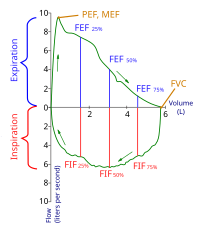
Photo from wikipedia
Background: Body habitus, pneumoperitoneum, and Trendelenburg positioning may each independently impair lung mechanics during robotic laparoscopic surgery. This study hypothesized that increasing body mass index is associated with more mechanical… Click to show full abstract
Background: Body habitus, pneumoperitoneum, and Trendelenburg positioning may each independently impair lung mechanics during robotic laparoscopic surgery. This study hypothesized that increasing body mass index is associated with more mechanical strain and alveolar collapse, and these impairments are exacerbated by pneumoperitoneum and Trendelenburg positioning. Methods: This cross-sectional study measured respiratory flow, airway pressures, and esophageal pressures in 91 subjects with body mass index ranging from 18.3 to 60.6 kg/m2. Pulmonary mechanics were quantified at four stages: (1) supine and level after intubation, (2) with pneumoperitoneum, (3) in Trendelenburg docked with the surgical robot, and (4) level without pneumoperitoneum. Subjects were stratified into five body mass index categories (less than 25, 25 to 29.9, 30 to 34.9, 35 to 39.9, and 40 or higher), and respiratory mechanics were compared over surgical stages using generalized estimating equations. The optimal positive end-expiratory pressure settings needed to achieve positive end-expiratory transpulmonary pressures were calculated. Results: At baseline, transpulmonary driving pressures increased in each body mass index category (1.9 ± 0.5 cm H2O; mean difference ± SD; P < 0.006), and subjects with a body mass index of 40 or higher had decreased mean end-expiratory transpulmonary pressures compared with those with body mass index of less than 25 (–7.5 ± 6.3 vs. –1.3 ± 3.4 cm H2O; P < 0.001). Pneumoperitoneum and Trendelenburg each further elevated transpulmonary driving pressures (2.8 ± 0.7 and 4.7 ± 1.0 cm H2O, respectively; P < 0.001) and depressed end-expiratory transpulmonary pressures (–3.4 ± 1.3 and –4.5 ± 1.5 cm H2O, respectively; P < 0.001) compared with baseline. Optimal positive end-expiratory pressure was greater than set positive end-expiratory pressure in 79% of subjects at baseline, 88% with pneumoperitoneum, 95% in Trendelenburg, and ranged from 0 to 36.6 cm H2O depending on body mass index and surgical stage. Conclusions: Increasing body mass index induces significant alterations in lung mechanics during robotic laparoscopic surgery, but there is a wide range in the degree of impairment. Positive end-expiratory pressure settings may need individualization based on body mass index and surgical conditions. Obese patients demonstrated increased driving pressures and decreased mean end-expiratory transpulmonary pressures. Pneumoperitoneum and Trendelenberg position further accentuated these differences. The optimal positive end-expiratory pressure was greater than set positive end-expiratory pressure in most subjects at all stages, ranging from 0 to 36.6 cm H2O. Intraoperative positive end-expiratory pressure settings should account for dynamic changes in transpulmonary driving and end-expiratory pressures related to these factors. How best to accomplish this clinically remains uncertain. Supplemental Digital Content is available in the text.
Journal Title: Anesthesiology
Year Published: 2020
Link to full text (if available)
Share on Social Media: Sign Up to like & get
recommendations!